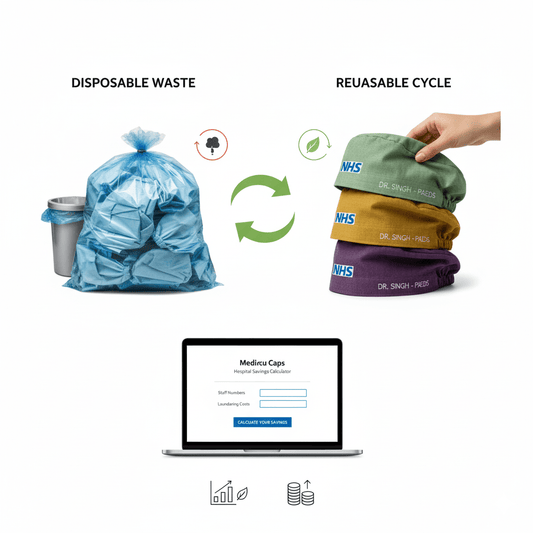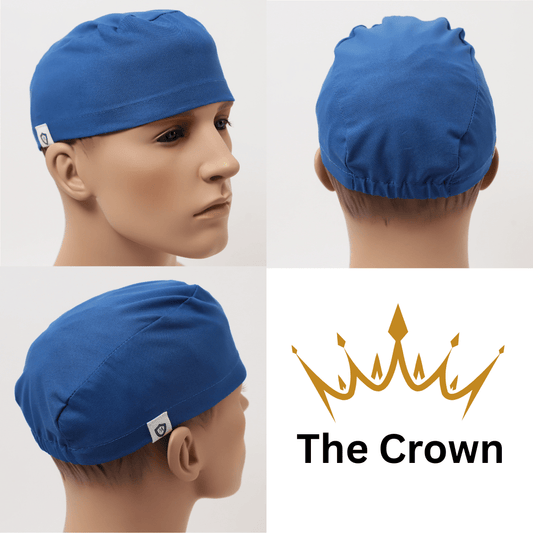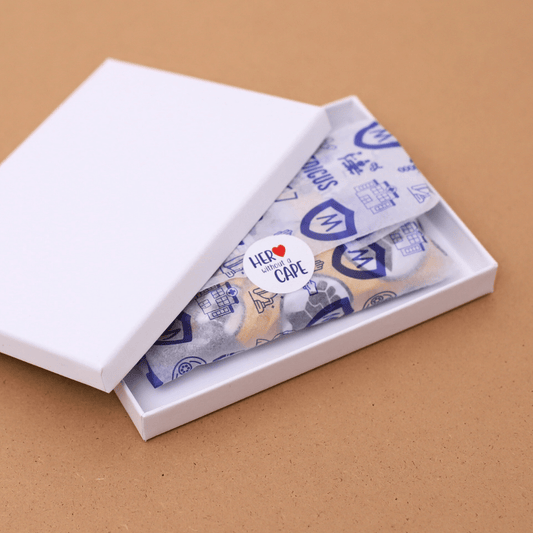
Impacto de CO₂e de los gorros quirúrgicos desechables de polipropileno SMS (fabricados en China)
Los gorros quirúrgicos desechables fabricados con polipropileno SMS (Spunbond-Meltblown-Spunbond) tienen una huella de carbono en cada etapa de su ciclo de vida. Este artículo proporciona un desglose de las emisiones de CO₂ equivalente (CO₂e) desde el principio hasta el fin, que abarca la producción, el envío y la eliminación al final de la vida útil . Luego, los combinamos para explorar cuatro escenarios: (1) flete marítimo + vertedero, (2) flete marítimo + incineración, (3) flete aéreo + vertedero y (4) flete aéreo + incineración.
1. Emisiones de producción (fabricación en China)
Materia prima (tejido SMS de polipropileno): la producción de resina de polipropileno (PP) es intensiva en carbono. Las estimaciones típicas indican que se emiten entre 1,5 y 2,0 kg de CO₂e por kg de PP, y algunos estudios indican que se emiten hasta ~3,5 kg/kg, dependiendo de la eficiencia del proceso. Un valor representativo es de aproximadamente 1,9 kg de CO₂e por kg . Dado que cada gorro quirúrgico desechable puede pesar alrededor de 5 a 10 gramos, la producción de materia prima puede contribuir aproximadamente con 10 a 20 g de CO₂e por gorro.
Energía de fabricación (red con alto contenido de carbón): la conversión de resina en tejido SMS y el montaje de la tapa requieren calor y electricidad, a menudo provenientes de energía a base de carbón en China. Las emisiones de electricidad de China pueden promediar alrededor de 537 g de CO₂/kWh . La producción de tejido y el montaje final pueden agregar otros 5-10 g de CO₂e por tapa, dependiendo de la intensidad energética. En total, la etapa de producción (materias primas + fabricación) generalmente ronda los 10-30 g de CO₂e por tapa.
2. Emisiones del transporte marítimo (de China a los principales mercados)
Transporte marítimo (buque portacontenedores): el transporte marítimo es más eficiente que el transporte aéreo. Los buques de carga emiten aproximadamente entre 10 y 40 g de CO₂ por tonelada-kilómetro . En un recorrido de aproximadamente 10 000 km (por ejemplo, de China a EE. UU./UE), el envío de unos pocos gramos por contenedor equivale a solo entre 1 y 2 g de CO₂e por contenedor de desguace. En otras palabras, es insignificante en comparación con las emisiones de producción.
Transporte aéreo (avión de carga): en cambio, el transporte aéreo de carga emite unos 500 g de CO₂ por tonelada-kilómetro, unas 20-30 veces más que el transporte marítimo. Transportar una cápsula de 5 g a lo largo de unos 10.000 km por aire puede añadir unos 20-30 g de CO₂e por cápsula . Por tanto, el transporte aéreo puede igualar o superar la huella de producción de cada cápsula.
3. Emisiones al final de la vida útil (eliminación)
Incineración (conversión de residuos en energía): cuando se incinera polipropileno, casi todo su carbono se libera en forma de CO₂. La quema de 1 kg de PP produce entre 2,7 y 3,0 kg de CO₂. Por lo tanto, una tapa de 5 a 10 g produce entre 13 y 30 g de CO₂ únicamente por incineración. Se trata de un aumento significativo de la huella de carbono total, que a menudo representa hasta el 40 % de las emisiones del ciclo de vida de un EPI desechable si se incinera.
Vertedero: En un vertedero, el polipropileno se degrada de forma extremadamente lenta y, por lo tanto, libera un mínimo de GEI a corto plazo. Los estudios muestran que el CO₂ o CH₄ inmediato del PP en vertedero es insignificante , por lo que, desde una perspectiva climática , el vertido de residuos plásticos añade muy poco CO₂e en la fase de eliminación. Sin embargo, genera contaminación plástica a largo plazo y otros problemas ambientales.
4. Emisiones totales de CO₂ por habitante: cuatro escenarios
Combinando la producción, el envío y la eliminación, podemos estimar el CO₂e total por tapa de depuración en cuatro escenarios:
-
Transporte marítimo + vertedero : escenario de menores emisiones.
Producción (~15 g CO₂e) + transporte marítimo (~1–2 g) + vertedero (~0 g). ≈ 15–18 g CO₂e por cápsula. -
Transporte marítimo + incineración
Producción (~15 g) + transporte marítimo (~1–2 g) + incineración (~10–15 g). ≈ 25–30 g de CO₂e por tapón. (En la práctica, a menudo alrededor de 20 g. Un estudio de la UE encontró ~17 g de CO₂e para un tapón de PP desechable https://www.ncbi.nlm.nih.gov/pmc/articles/PMC8423212/ , lo que implica incineración y transporte marítimo. Un tapón más pesado o una combustión completa podrían aumentar el total). -
Transporte aéreo + vertedero
Producción (~15 g) + transporte aéreo (~20–30 g) + vertedero (~0 g). ≈ 35–45 g de CO₂e por persona. El transporte marítimo predomina, duplicando aproximadamente la huella en comparación con el transporte marítimo. -
Transporte aéreo + incineración : escenario de mayores emisiones.
Producción (~15 g) + transporte aéreo (~20–30 g) + incineración (~10–15 g). ≈ 45–60 g de CO₂e por cabeza. Esto puede ser 3–4 veces mayor que el escenario 1 debido tanto al transporte aéreo como a las emisiones de la incineración.
Resultados: El transporte marítimo y el depósito en vertederos producen las emisiones de CO₂e más bajas (apenas unas decenas de gramos de CO₂e por tapa). Por el contrario, el transporte aéreo o la incineración pueden aumentar sustancialmente la huella, ya que cada uno de ellos añade decenas de gramos de CO₂e. Por ejemplo, una tapa enviada por aire puede emitir tanto CO₂ en tránsito como el generado durante la producción, mientras que la incineración libera inmediatamente el carbono atrapado en el plástico. Una evaluación del ciclo de vida de las tapas quirúrgicas concluyó que las tapas desechables de PP tenían unos 17 g de CO₂e cada una en condiciones de uso típicas (fabricación en Asia, envío marítimo e incineración). Nuestras estimaciones anteriores muestran cómo la variación del modo de envío y la elección de eliminación pueden hacer variar las emisiones totales en un factor de 2 a 3 veces.
En general, la logística y el manejo de los desechos afectan significativamente las emisiones totales de los gorros quirúrgicos desechables. La fase de producción establece una línea de base (PP de origen fósil más energía con alto contenido de carbón), pero el método de envío y la eliminación al final de la vida útil pueden cambiar enormemente la huella final. Optar por el transporte marítimo (envío más lento) y la eliminación en vertederos puede reducir a la mitad el impacto de CO₂e en relación con el transporte aéreo y la incineración. En la práctica, las regulaciones de control de infecciones y la urgencia del suministro pueden prevalecer sobre las consideraciones puramente ambientales; sin embargo, comprender estas compensaciones es crucial para estrategias de adquisición más sostenibles. Si bien la huella de cada gorro es modesta en gramos de CO₂, el uso a gran escala puede magnificar estas diferencias.
Fuentes
-
Emisiones de la producción de polipropileno:
https://winnipeg.ca/enviro/LiveSafeWasteLess/Plastic.asp
https://small99.co.uk/factsheets/the-carbon-footprint-of-plastic/ -
Factor de emisión de electricidad de China:
https://www.climate-transparency.org/wp-content/uploads/2021/10/CT2021China.pdf -
Emisiones del transporte aéreo y marítimo:
https://www.sourcinghub.io/blog/air-freight-vs-sea-freight -
Incineración frente a emisiones de carbono en vertederos:
https://www.diva-portal.org/smash/get/diva2:1530506/FULLTEXT01.pdf
https://publications.jrc.ec.europa.eu/repository/bitstream/JRC99180/lfna27625enn_002.pdf -
Datos de ACV para tapones desechables de PP:
https://www.ncbi.nlm.nih.gov/pmc/articles/PMC8423212/





